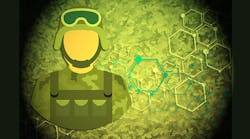A new method for testing the durability of polymers—courtesy of researchers at the Army Research Lab and the Massachusetts Institute of Technology—has revealed that some materials appear to strengthen themselves when struck by rapidly moving objects. These materials could be used in future U.S. Army helmets and armor.
The engineers discovered that when targets made of poly(urethane urea) elastomers (PUUs) are hit at high speed by micro-particles made of silica, the target displays hyper elastic behavior. That is, they become extremely stiff when deformed at strain rates on the order of 108/sec, which means the target material deforms to half its original thickness in an extremely short time (one second divided by hundred millions). PUUs also quickly return to their original shape after the impact.
The scientists say their discovery on bulk elastomers can help design matrix materials for composites and use them for future Army combat helmets. The Army’s current combat helmet is made of ultrahigh molecular weight polyethylene or UHMWPE fibers-based composites. These fibers have high breaking strength per unit cross section area—about 15 times stronger than steel—but are flexible like fabrics.
Armor used to protect soldiers and vehicles has traditionally been comprised of ceramics, metals, or lightweight fiber-reinforced composites, which are typically based on stiffness (the resistance of a material against deformation) and toughness (the ability to absorb energy and plastically deform prior to fracture).
But from a materials science perspective, these standard metrics are not enough to quantify how quickly molecules in a polymer solid change mobility with respect to deformation rates, nor the propensity toward changing their physical state during deformation.
The team studied PUUs along with a glassy polycarbonate. Although polycarbonate has high fracture toughness and ballistic strength, PUUs had greater dynamic stiffening during impact at strain rates on the order of 108/s. Furthermore, they resisted penetration of the micro-particles. Changing the PUU’s composition in one instance lead to a roughly 50% reduction in maximum penetration depth.
PUUs have complex microstructures, along with a broad range of relaxation times, and these characteristics indicate how efficiently molecules in their polymer chains respond to external impulses. For PUUs molecules with relaxation times on the order of microseconds, slower dynamics lead to dynamic stiffening. PUUs with nanosecond relaxation times provide additional energy absorption. These viscoelastic characteristics show that elastomers, as well as other polymeric materials, may deform differently depending on how fast it is deformed.
The team hypothesizes that PUUs exhibit a cooperative molecular relaxation mechanism with a cascade of molecular motions, each oscillating at specific frequencies to dissipate absorbed energy. These dynamic strengthening and stiffening characteristics could presumably be increased by intermolecular hydrogen bonds present throughout physically-crosslinked PUUs. In contrast, there is no microsecond relaxation in polycarbonate, nor is hydrogen bonding available in polycarbonate, despite its toughness and impact strength. Thus, PUUs or high-performance elastomers with several relaxation times are key to dynamic strengthening and stiffening over a time scale from microseconds to nanoseconds.
PUUs, polyurethanes, and similar elastomers that exhibit dynamic strengthening in high-rate deformations that limit deformations of the helmet under impact would make for better combat helmets. Other possible military uses include face shields, ballistic vests, protective gear for legs and arms, and blast-resistant combat boots. On the civilian side, they could protect football players and young athletes against concussions and other brain-related injuries brought upon by collisions. From the design perspective, the PUUs can be used as the helmet’s outermost layers or to replace the polycarbonate shell.

